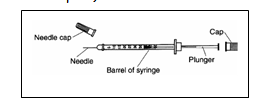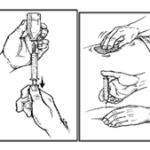You take Insulin by subcutaneous (the tissue below the skin layer) injection; it can also be given intravenously in emergency clinical conditions during hospital admissions.
How do I take insulin?
You take Insulin by subcutaneous (the tissue below the skin layer) injection; it can also be given intravenously in emergency clinical conditions during hospital admissions.
What do I require for Insulin injection?
For Insulin injection, you require the prescribed Insulin bottle (also called vial; available in 40units/mL and 100units/mL strengths), Insulin syringe (see picture below; available as 40units/mL syringe and 100units/mL syringe) and spirit swab (cotton soaked in spirit).

What precautions should I take before Insulin injection?
Ensure that your food will be ready in the next 20-30minutes; get yourself ready for food in the next 20-30minutes; get the appropriate Insulin vial and syringe (use 40units/mL syringe ONLY for 40units/mL vial and 100units/mL syringe ONLY for 100units/mL vial) and be sure of the dose of Insulin to be injected; make sure that the liquid in the vial is appropriate for use – Insulin that has clumps or solid white particles should not be used and clear Insulin should not be turbid.
Where should I inject insulin?
Insulin can be injected in the abdomen (around the navel), front and sides of the thighs or sides of upper arms. Move the injection sites around in one area (around 3 to 4 cm away from the last one) and change the area every week or fortnight.
How do I inject Insulin subcutaneously?
- Keep the Insulin vial at room temperature for a while; you need to roll the vial between your palms for 15 seconds if you are using Insulin that is milky
- Wash your hands clean with soap and water
- Wipe the cap of the vial with a spirit swab; wait till the spirit dries
- Take the Insulin syringe and remove the caps from both ends of the syringe
- Insert the needle through the rubber cap of the vial. Then turn the vial upside down. Push the syringe until the needle tip reaches the liquid medication inside
- Gently withdraw the plunger down until the required amount of Insulin is loaded in the syringe
- Remove the syringe from the vial. If there are air bubbles in the syringe, hold the syringe with the needle up, gently tap the syringe with the finger and let the air float to the top. Push the plunger of the syringe gently to move the air bubbles out
- If the dose of Insulin loaded in the syringe is less, repeat the steps 5, 6 and 7 till the correct dose is taken
- If excess Insulin is taken, then insert the syringe into the vial and gently push the plunger till the extra dose of Insulin is pushed back into the insulin bottle
- If you have to take two types of Insulin, both can be loaded in the same syringe provided the sum of the prescribed units is less than or equal to the units capacity of the syringe. In this situation, you load short acting Insulin first and the other one second; you then gently roll the loaded insulin syringe between your palms
- Choose a site convenient for you to inject Insulin. Clean that site with spirit swab and wait till the spirit dries
- Pinch a fold of skin with your left hand. Hold the barrel of the syringe with your right thumb and index finger and pierce the needle over the top of the fold of the skin keeping the syringe straight (at 90 degree angle to the skin)
- Let go the fold of skin and hold the syringe with your right index and middle fingers with the thumb on the end of the plunger. Gently push the plunger till all the Insulin is injected subcutaneously
- Leave the needle for 5 to 10 seconds to prevent the back leak of Insulin; then pull the needle out. Clean the area with spirit swab if required but do not rub the site
- Apply caps over the syringe if you are reusing the syringe; keep the vial in the location recommended for storage.
How do I store Insulin?
Unopened Insulin vials should be stored in a refrigerator door (do not freeze). Opened, in use Insulin vials can be stored at room temperature for up to 30 days. However do not expose it to direct sunlight or heat.
What are the side effects of Insulin injection?
Apart from occasional ooze and insignificant pain, Insulin injection is safe if proper technique is followed. The risks will be more if syringes are reused or the needle is blunt or the same site is used for injection.
What do I do when I am travelling?
You can carry your Insulin vial and syringe with you during travel but make sure the vial is not exposed to direct sunlight or heat.
When do I change the Insulin syringe?
It is recommended not to reuse Insulin syringe because of the concerns for microscopic injury to the tissue at the site of injection and microscopic damage to the needle tips following needle reuse. Cap the syringes to be disposed and keep them in a screw capped tough plastic container for subsequent safe disposal. If you are reusing syringe, change to a new syringe after 5-6 uses or earlier if the injections become painful or the needle is bent or damaged.
When should I call / consult the doctor?
Apart from routine consultation, you can call your doctor if you have any queries or doubts on Insulin use or if you have problems in using Insulin or when blood sugar is not under control.

